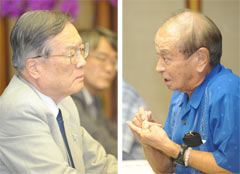Okinawa Governor has difficulty accepting the Osprey to Futenma Air Station

On August 29, at the Okinawa Prefectural Office, Defense Minister Satoshi Morimoto (left) reported to Okinawa Governor Hirokazu Nakaima on the results of the investigation into the crash of an MV-22 Osprey in Morocco this April.
August 30, 2012 Ryukyu Shimpo
On August 29, Defense Minister Satoshi Morimoto visited Okinawa to report on the results of the investigation into the crash of an MV-22 Osprey that occurred in Morocco this April. During his stay he met with Okinawa Governor Hirokazu Nakaima, Ginowan Mayor Atsushi Sakima and the heads of the municipalities affected by the Osprey’s proposed flight routes. Although Morimoto stated that there is no problem with the aircraft itself, Nakaima opposed the deployment of the Osprey to U.S. Marine Corps Futenma Air Station, stating, “We cannot say that the Okinawa Prefectural Government will accept the deployment plan until the U.S. government resolves the safety issues around this aircraft.” Sakima again demanded that the plan to deploy the aircraft be cancelled, saying, “I have to oppose the plan. I want the U.S. and Japanese governments to reconsider it for the sake of the safety of more than 94000 citizens.” The heads of the municipalities strongly criticized the Japanese government, saying that the submission of the crash investigation results is designed to create a pretext for the deployment of the Osprey.
Nakaima talked to the media after meeting Morimoto, saying, “It is unacceptable to say that the Osprey is a safe aircraft because the problems were caused by human error.” When asked if he will attend the rally to protest against Osprey deployment that is scheduled to be held on September 9, Nakaima did not commit himself, saying, “I need a bit more time on that.”
In the meeting at the Okinawa Prefectural Office, Morimoto said that the team of experts sent to the United States by the Japanese government attributed the cause of the Osprey accident to an error by the copilot. Morimoto said that the Japanese government deplored the sexual assault resulting in injury caused by an U.S. Marine and demanded to the Okinawa Area Coordinator’s Office of U.S. Forces that strict discipline be enforced among its personnel.
Nakaima asked the Japanese government to provide a thorough confirmation of the safety of the Osprey, saying, “Our concerns over the aircraft will be assuaged if the Japanese government can clearly indicate the cause of the accidents and make Okinawan people understand that the Osprey is safe.”
After the meeting, Morimoto also talked to the media. He said, “I took particular note of what the governor said. I will talk to the Foreign Minister and Prime Minister about confirmation of safety issues. Morimoto denied the report stating that the Japanese and U.S. governments plan to deploy the Osprey to Futenma Air Station in the middle of September, saying, “If you define the word ‘deployment’ as the state in which the unit is ready to undertake its mission, then the Osprey will not be deployed to Futenma by the middle of next month. I do not recall the Japanese government making such a promise to the U.S. government.” However, Morimoto maintained an attitude of proceeding with consultation with his U.S. counterpart on the premise of the deployment of the Osprey to the base, saying, “We will aim to ensure safety of the aircraft through consultation between the Japanese and U.S. governments.”
That night, Morimoto boarded a Self-Defense Forces aircraft bound for Yamaguchi Prefecture, where the Osprey aircraft are currently located.
(English translation by T&CT, Mark Ealey)
Previous Article:Miruku Unke parade held to pray for good health
Next Article:Calbee opens shop in Naha
[Similar Articles]
- Okinawa Governor tells Defense Minister: “If the governments bulldoze their way to deploy the Osprey, all U.S. bases will be closed immediately.”
- Okinawa Governor criticizes Japanese government for understating Osprey emergency landing in North Carolina
- Protest rally held in Ginowan against deployment of the Osprey to Futenma Air Station
- Prime Minister does not accept Okinawa Governor’s request for withdrawal of Osprey aircraft
- U.S. Government to deploy MV-22 Osprey to Futenma in July, ahead of schedule
 Webcam(Kokusai Street)
Webcam(Kokusai Street)


